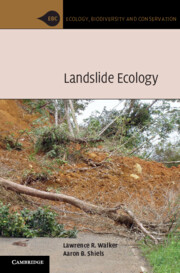3 - Physical causes and consequences
Published online by Cambridge University Press: 05 January 2013
Summary
Key points
The propensity for a landslide to occur is largely determined by potential slip planes, or weakness planes in the geological substrate, where the driving forces exceed resisting forces.
Landslide occurrence across the landscape is often unpredictable; substrates can be resistant to slippage for centuries and then suddenly experience instability that may result from human or non-human changes that disrupt the balance between driving and resisting forces at a slip plane.
Post-landslide erosion is common and can contribute as much as 33% of the total sediment loss from the site of landslide initiation. Such post-landslide erosion can continue for years, which reduces rates of ecosystem recovery on landslide scars and alters down slope habitats and watersheds.
Landslides greatly alter soils through physical losses, gains, and mixing, as well as through chemical changes. Soil organic matter contains critical nutrients and retains moisture; it facilitates soil and plant recovery in microhabitats present after a landslide. In warm, tropical regions, some landslide soil chemistry may recover to pre-landslide conditions within 55 years, yet such recovery is much slower in cooler, temperate regions.
Introduction
What causes a landslide? This is an important question, both ecologically and for human safety and hazard management. Landslides occur on sloped terrain, making topography a crucial component for landslide occurrence. However, the underlying factors that control whether or not a landslide is triggered include the conditions of the local soil and rock substrate. Below the ground surface, a complex combination of geological, topographical, hydrological, historical, climatological, and biological factors in addition to random disturbances interact and influence whether a landslide occurs (Table 3.1). Most of the below-ground characteristics that affect landslide occurrence are not fixed, but instead constitute dynamic interactions that can fluctuate in minutes or seconds. Water is absorbed and drained from soils at multiple scales and rates, which disrupts balances between driving and resisting forces. Seemingly static components of a hill slope, such as rock and soil, are also in a state of flux. Rock slabs can be split or pulverized through mechanical weathering, such as when moisture or roots penetrate cracks in bedrock and expand either by freezing or growing, respectively. Moisture, and the organic acids exuded by plants, can degrade rock surfaces and alter soil chemistry. Earthworms may increase infiltration, aeration, and organic matter decomposition (see Section 4.6.1).
- Type
- Chapter
- Information
- Landslide Ecology , pp. 46 - 82Publisher: Cambridge University PressPrint publication year: 2012
- 2
- Cited by

